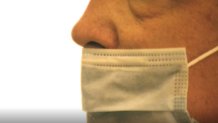Women in Philadelphia have done a better job than men of wearing masks and wearing them correctly, according to preliminary results of a study released Tuesday. Overall, usage was low in parks and on playgrounds in particular, and highest in commercial areas where stores will bar entry to unmasked customers.
As Philly officials reported low case counts of the coronavirus - the lowest since the start of the epidemic - results of that independent study showed low mask usage in some spots of the city.
During three weeks in August, researchers observed 4,600 people outdoors in public spaces in the city, and found 43% of those people had a mask and were wearing it correctly. Another 17% had a mask but were not wearing it properly, a figure that includes people not covering their nose with the mask or leaving the mask under their chin.
Expressed differently, more than half the people observed in the study were not properly protecting themselves and others according to health guidelines. Forty percent of people observed had no mask visible.
The situation was better in commercial corridors, which, along with SEPTA stations, have been the focus of previous city data on mask usage - (you can click the masks tab at that link to see the city chart). The city health department says it has focused mask studies on people leaving retail stores, because that is a better measure for mask usage indoors, where the virus is more likely to spread.
This latest study, from staff at Studio Ludo, Kaiser Permanente, San Diego State University and the RAND Corporation was conducted outdoors on commercial blocks, parks and playgrounds.
In the study, 72% of people studied had a mask with them when they visited commercial corridors. Just 51% were observed wearing them correctly. Others may have removed their mask outside after exiting a store or leaving their workplace or public transit - all situations that require masks.

The study also found women were more likely than men to have a mask. Also, women were more likely than men to wear masks correctly.
The lowest portion of masks worn correctly was observed on playgrounds at 21%. That rate dropped to 15% when observing children under 12 at the playgrounds.
Health officials have said anyone over age 2 should wear a mask outside when they cannot safely keep 6 feet of distance from people outside their household.
You can see the rest of the study data and a map of the sites researchers visited here. The study also breaks down mask usage by race and age groups - with people over 60 wearing them most frequently.
"Most Philadelphians are doing the right thing most of the time, but we all need to wear masks more regularly. And we need to wear masks more consistently, even if we’re outdoors or when near others,” Philadelphia's health commissioner Dr. Thomas Farley said in a news conference on the coronavirus Tuesday.
He's one of several health officials who have pointed out research that shows masks and face coverings can prevent the spread of respiratory droplets that could contain the coronavirus. To snag those droplets, he recommended using a mask that can be held up to the light without much light shining through. Farley did not recommend bandanas, or construction masks that contain a valve - those may not effectively prevent your droplets from getting loose.
Now the department is releasing a flyer to educate people on better mask use. Be sure to cover your nose and fix the mask over the bridge of your nose.
"The basic principles are clear: you should cover your mouth and your nose," Farley said. "It doesn't do any good to have the mask cover your mouth only, or have the mask down here on your neck. To state the obvious, you don't breathe through your neck."
"And this is something that I see really frequently, that really bothers me: don't pull your mask down and talk to the person next to you," Farley continued. "When you're talking to the person next to you is when you're most putting out those water droplets, that's the most important time to have the mask on."
"In general, I believe that a lot of the progress we've made of this epidemic is because people are wearing masks," Farley said. "...So if you're wearing a mask at all, thank you very much. But now that most people have made that change, it's time to wear the right kind of mask and wear them more consistently."
Low case counts
A week of testing data ending Sept. 12 shows the lowest case counts and positivity rates seen since the beginning of the epidemic, Farley said.
The city was averaging 67 cases per day last week, the data shows. And of people tested, just 2.6% were positive. Farley said the numbers were a credit to all the virus prevention efforts in which residents have taken part.

